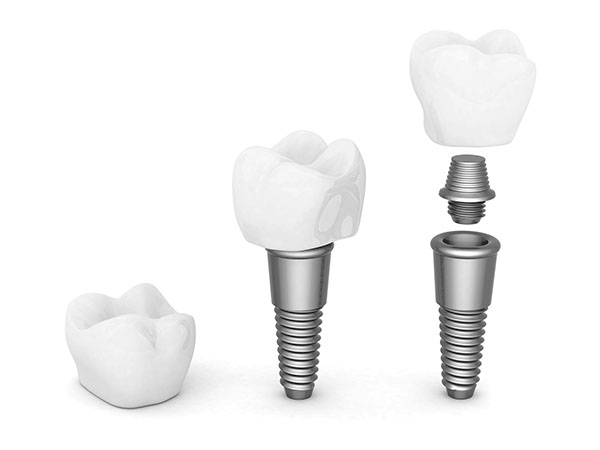 Today’s dental implants are a culmination of years of research and fine-tuning that started with ideas formed in ancient times. The procedures, techniques, and materials we use are completely revolutionary, giving you the most perfect dental implant to place a crown, denture, or bridge on. Our goal has always been seamless integration, where the body accepts the implant as part of the natural order, and the bone grows around it for maximum strength and stability. The use of titanium has greatly enhanced our ability to do that. Today’s dental implants use a process, unique to titanium, called osseointegration that causes the body to fuse precisely the way we would like. This biointegration helps add a layer of complexity to the implant, literally making it a part of your mouth. In order to help facilitate this kind of development, some implants are actually coated with hydroxyapatite, which naturally occurs in the bone and the presence of which greatly reduces the body’s chances of rejecting the implant itself.
Today’s dental implants are a culmination of years of research and fine-tuning that started with ideas formed in ancient times. The procedures, techniques, and materials we use are completely revolutionary, giving you the most perfect dental implant to place a crown, denture, or bridge on. Our goal has always been seamless integration, where the body accepts the implant as part of the natural order, and the bone grows around it for maximum strength and stability. The use of titanium has greatly enhanced our ability to do that. Today’s dental implants use a process, unique to titanium, called osseointegration that causes the body to fuse precisely the way we would like. This biointegration helps add a layer of complexity to the implant, literally making it a part of your mouth. In order to help facilitate this kind of development, some implants are actually coated with hydroxyapatite, which naturally occurs in the bone and the presence of which greatly reduces the body’s chances of rejecting the implant itself.
The biggest concern, dental implant recipients used to have was the body’s potential for rejecting the device. Titanium, along with some innovative ideas, designs, and even shapes have taken great strides in reducing this possibility. Today we have a variety of surfaces available for the best integration opportunities including plasma-sprayed, hydroxyapatite-coated, grit-blasted, and acid-etched devices. There are also a variety of types of dental implants that are used though these are typically based on biology and are less about choice. Some implants best serve the patient when they are installed directly into the jaw, underneath where the new tooth will go. If the jawbone cannot support an implant, we have creative ways of working around this as well so that you can have the teeth you desire.
The most commonly used dental implants are known as Endosseous implants or root-form implants. They are designed to fit into the jawbone directly below where we plan to install the fake tooth. There is one important criterion that the bone must meet in order for us to perform this implant. The jawbone has to be stable and have enough density to be able to withstand and sustain the device. Root form implants are typically installed in two phases. The first involves burying the dental implant in the gum for a period of time and then exposing it for the second surgical procedure. There are times, however, when we may choose to do the entire process in one session.
Less commonly used is the Ramus frame dental implant. These implants are designed for people who have less bone density and cannot support a standard implant. If the jawbone is too weak or there is a risk that the implant may fracture the jaw, we will use the Ramus-frame method. The implants are often anchored in the back of the mouth near the wisdom teeth or in the front near the chin. A thin metal rod runs across the length of the implant, which allows us to place a bridge or a denture.
